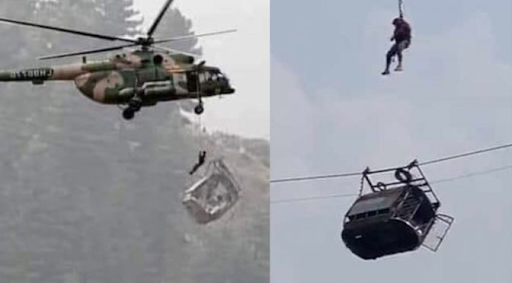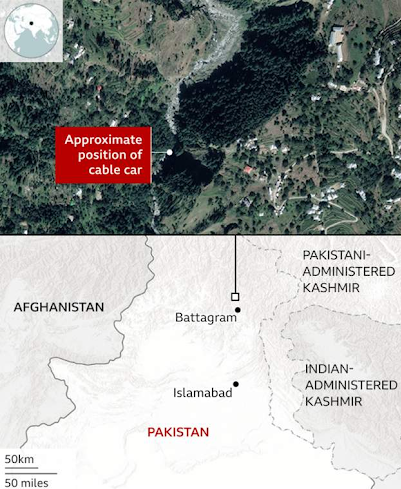
As darkness envelops the Battagram region, the painstaking efforts to rescue trapped passengers from a cable car suspended hundreds of feet above the ground are ongoing. The challenging operation has led the army to enlist zip line experts to aid in the rescue, highlighting the complexity of the situation.
The cable car, a vital mode of transport for locals, was on its fifth trip of the day when tragedy struck. Its cables snapped, leaving eight individuals, including six children, stranded precariously in mid-air. The situation was made even more complicated by gusty winds and fading light, prompting authorities to abandon helicopter rescue operations for the night.

In an effort to navigate the difficulties posed by the harsh conditions, the army brought in cable and zip line specialists from a private company in the Naran region. These experts, airlifted to the scene, possess the skills needed to address the unique challenges of this operation. Their involvement underscores the gravity of the situation and the need for precise expertise to ensure the safety of both rescuers and those trapped in the cable car.
The urgency of the situation has led to officials working on alternative rescue plans. A new rope is being laid on both sides of the cable car, offering a contingency option should helicopter extrication prove unfeasible. This demonstrates the multifaceted nature of rescue operations, requiring backup strategies to adapt to the evolving conditions.

As the rescue efforts continue, emotions run high among families and community members waiting anxiously for news of their loved ones. Maulana Abdul Qayyum, whose son and brother are among the stranded, expressed concern that time is running out as night falls. He emphasized the need for a swift resolution to prevent the operation from becoming even riskier due to the darkness and worsening conditions.
The situation has also captured the attention of the nation’s caretaker prime minister, Anwaar ul Haq Kakar, who commended the progress achieved so far and lauded the combined efforts of various agencies involved in the operation. The sense of unity and collaboration among military personnel, air force, rescue organizations, and district administration is evident as they work tirelessly to bring the trapped individuals to safety.

The inherent challenges of this rescue operation also shed light on the broader context of cable car incidents worldwide. While cable cars are generally considered safe, they are not immune to accidents, as seen in this instance and past incidents in different parts of the world. The rarity of such events underscores the uniqueness of each situation and the need for adaptability in response.
As we await further updates on the rescue efforts, the coming hours will be crucial in determining the fate of those still trapped in the cable car. The involvement of experts, the deployment of alternative strategies, and the dedication of all involved serve as a testament to the resilience and unity of a community facing an unforeseen challenge. The plight of the stranded individuals remains at the forefront, reminding us of the fragile nature of life and the unwavering human spirit in times of adversity.





